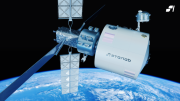Have you heard of the Electra project? A project born of a partnership between ESA and the satellite operator SES, Electra is expected to be launched in 2018. If everything goes according to plan, it will signal the beginning of a real revolution in space: the end of heavy, cumbersome hydrazine tanks. ESA is counting on a 40% reduction in mass for twice the payload. And above all, the electricity would be supplied by solar panels feeding into small engines to keep the
satellite on the correct orbit. We have apparently invented permanent, free energy.
So what about hydrazine, that particularly explosive chemical product? We can all bring to mind pictures of tank refuelling from Kourou in which the fuelling staff are dressed in special overalls to protect them in the event of fire or explosion. Clearly, refuelling is a high risk manoeuvre. But large geostationary satellites have only been able to complete their missions thanks to this very hydrazine. For example, Spot 5 has a hydrazine engine enabling weighty re-aiming manoeuvres, including de-orbiting at the end of life. Ariane 5’s equipment bay is the control, guidance
and steering centre of the launcher. It orchestrates all commands and flight controls, with flying instructions given by the on-board computers based on information provided by guidance centres. The architecture of the altitude control system also includes two titanium tanks each containing 38 litres of hydrazine as well as small thrusters to provide altitude correction.
We have undeniably entered the post-hydrazine era: electric propulsion for satellites has even just been written into the list of 34 projects selected by the government as technologies of the future. CNES, the French space agency, has been appointed project manager, since France is ahead of the field in this area. SNECMA for example was a pioneer for electrical propulsion in Europe, its first work dating back to the 1960s. It gave us plasma engines in 1993 which
currently equip many telecommunications satellites (including Intelsat and Inmarsat). This technology offers undeniable advantages: plasma thrusters eject xenon, with electrical energy supplied by solar panels. These engines are much more efficient than traditional chemical propulsion, consuming 5 to 6 times less propellant for a given mission.
With all-electric propulsion, we are entering a new era. Thanks to solar energy – totally green –, it is possible to envisage extended life satellites, since they will be in no danger of running out of fuel. And only equipment useful to the mission will be sent into space since the fuel system is eliminated. We can be reassured by the fact that solar panels work very well in space. Didn’t the Russians have the idea at one point of installing nuclear-powered
mini-thrusters…?
So long live electricity, decidedly in vogue! It is already making its entry into the aerospace industry with electrical brakes to equip airliners, there too making savings in terms of weight and efficiency. And the automobile industry is not left behind either: small engine cars are now equipped with electrical power steering. Let’s hear a round of applause then for hydrasyne and hydraulics and their historic role in our technological development. And a warm welcome to electricity, that old energy with plenty still up its sleeve!
Gérard Jouany – Aeromorning
Translated by L. Jones
Space propulsion: Soon an “all electric” satellite in orbit
 aerospace news
aerospace news














Be the first to comment on "Space propulsion: Soon an “all electric” satellite in orbit"